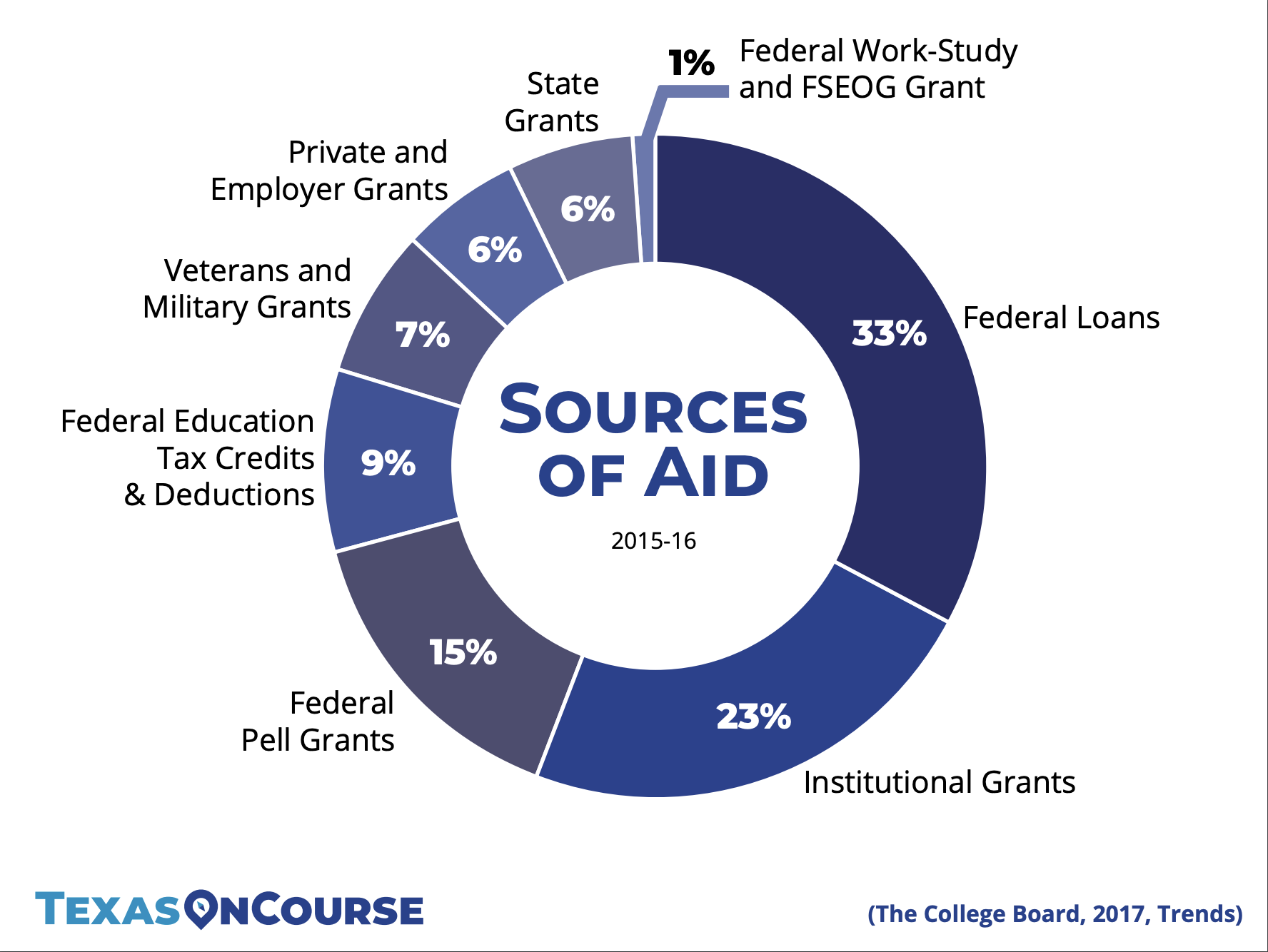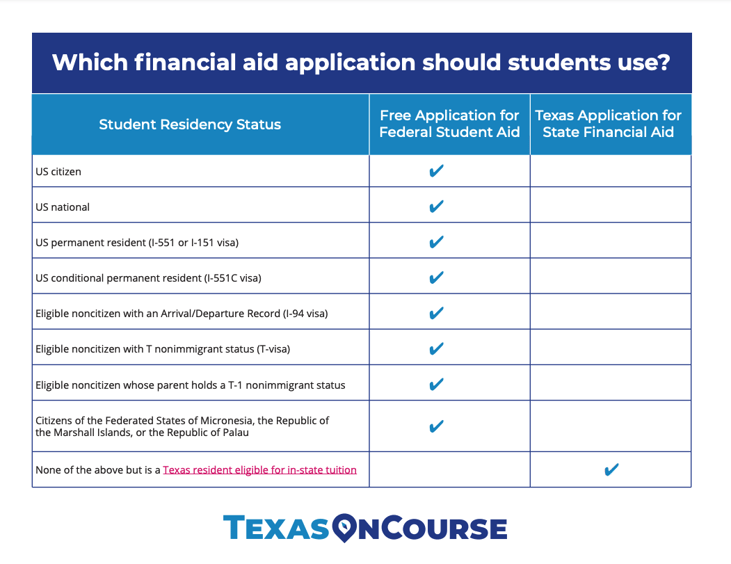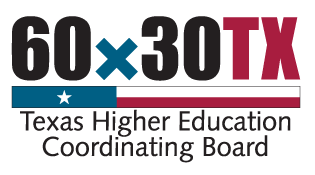Thinking about paying for college can seem like a daunting task for high school students and their families. After all, the average college cost has increased more than 25% in the last 10 years. Luckily, students have more financial aid opportunities now than ever before.
It’s important for high school counselors to understand the impacts of rising student debt. They should also note the different avenues available to pay for college and reduce student loans. Applications like the FAFSA, TASFA, and CSS Profile can seem overwhelming, but the benefit for eligible students can be huge.
In this guide, we'll include links to additional articles, webinars, videos, and other resources. And don’t forget to refer to the ultimate source for all postsecondary planning information for professionals: the Texas OnCourse Academy.
What you’ll find on this page
In this article, we’ll give you a complete breakdown of financial aid from an educator perspective – from the true cost of college to applying for financial aid and understanding financial aid award letters.
Click below to navigate to each section or keep scrolling to read it all!
- College costs
- Types of financial aid
- Financial aid applications
- Understanding financial aid award letters
- Accepting Financial aid
The true cost of college
To begin, let’s go over how to calculate the total cost of college. There are three types of college costs that every school counselor and CCMR instructor should know: direct costs, indirect costs, and total cost of attendance. Students and their families need to understand the complete cost of college as they apply to colleges, apply for financial aid, and decide what school to attend.
Direct college costs
Direct costs are what first come to mind when most people think about paying for college. These are monies paid directly to the school like tuition, fees, and room and board.
Direct costs may differ depending on the student. Universities often charge different tuition and fees depending on student status. Whether a student comes from in or out of state, lives on or off campus, or takes more or less than the average number of credits can all affect direct college costs. Students and their families should work with the financial aid office to calculate these personal costs rather than relying on tuition estimates provided online or through informational materials. Direct costs may also change from year to year.
Direct costs are an important piece of paying for college, but it’s important to keep in mind that students will likely incur other costs while attending school.
Indirect college costs
Every other expense that a student incurs during college is considered an indirect cost. Indirect costs are expenses that are not paid directly to a student’s school but are still associated with attendance. Books, transportation, and personal expenses or miscellaneous, as some colleges may call it, are indirect costs. If a student is planning to purchase meals besides what’s provided in a meal plan or live in off-campus housing, those expenses will also be considered indirect costs. Note: a meal plan is a part of room and board, which is a direct cost.
Colleges often estimate indirect costs in financial aid award letters, but students and their families should create their own estimates based on necessities, lifestyle, and personal factors. The American Council on Education notes that indirect costs could be up to 60% of a student’s total cost of attendance.
Cost of attendance
Cost of attendance is the total price for a year of college including both direct costs and indirect expenses. You should encourage students to think about how they can lower their cost of attendance by setting a budget, graduating on time, and taking advantage of assistance in addition to applying for financial aid.
To calculate cost of attendance, add up total direct and indirect costs for one year. Or use a calculator like the College Cost Calculator offered by the College Board here.
For more information on college costs – including common questions, handouts for students, and additional resources – log in and review the College Finances module in the Texas OnCourse Academy.
Types of financial aid
Once students have estimated their total cost of college, they should begin applying for financial aid. To find the optimum amount of aid, make sure students and their families understand the types of aid available and where to find the applications. There are four basic types of financial aid that may help a student pay for school: loans, grants, scholarships, and work-study.
Student loans
Loans allow students to borrow money for college and career school. Unlike scholarships and grants, students must repay their loans with interest. While loans may be a necessity for many, students should make sure to maximize other types of financial aid before taking on loans. Talk to students about repayment options to make sure they are prepared for successful loan repayment.
Grants
Grants are a type of gift aid that does not have to be repaid. In contrast to scholarships – which are often based on merit, affiliation, need, or other factors – grants are typically based on need.
Scholarships
Like grants, scholarships are a type of gift aid and do not require repayment. They are typically offered by individual institutions and private organizations. They can be awarded based on different factors such as academic performance, athletic ability, religious affiliation, and race or ethnicity. Students are often asked to write an essay as part of the scholarship application process. For more information, check out the Scholarship Applications module in the Texas OnCourse Academy.
Work-study
Enrolled students can earn money to help pay for school through this student work program. Work-study provides part-time employment, is available for both part-time and full-time students, and offers jobs on and off campus.
Sources of financial aid
Students may apply for financial aid from a variety of sources including federal student aid, state aid, institutional aid, and private loans and grants. Each of these sources may have different applications and methods for offering aid, so it is important to research each opportunity to maximize financial aid benefits.
Federal student aid
Federal student aid, offered by the US Department of Education, is the largest financial aid source in the nation. The federal government offers loans, grants, and work-study funds. To receive federal aid, eligible students must complete the FAFSA form, which opens in October and should be filled out every year.
Submitting the FAFSA makes students available for a variety of aid opportunities, including Pell Grants and Federal Supplemental Education Opportunity Grants. After filling out the FAFSA, students will receive the FAFSA student aid report, which gives basic information about a student’s eligibility for federal student aid as well as listing their answers to the FAFSA.
State aid
State governments provide grants, scholarships, work-study funds, state loans, and tuition assistance. In Texas, students who are state residents but not US citizens are ineligible to receive federal student aid but can apply for state aid by completing the Texas Application for Student Financial Aid (TASFA). Learn more about student eligibility for the TASFA.
Institutional aid
Institutional financial aid is provided by individual colleges and universities to their students. Colleges and universities typically offer scholarships, grants, and work-study programs. Students should talk to financial aid officers at colleges they are interested in to learn about available opportunities. Participating colleges may require students to complete a CSS Profile for institutional and nonfederal aid.
Private Loans and grants
Private loans and grants are often offered by banks, credit unions, private foundations, or other sources. While private loans can be a helpful tool for getting a student to college, these types of loans typically have higher interest rates and limited loan forgiveness opportunities. For this reason, private loans should be approached with caution. Encourage students to exhaust all other financial aid opportunities before accepting private loans. Explain both the benefits and risks involved with taking on the debt.
Financial aid applications
Once your student is aware of the types of student loans and sources, it is time to start researching aid applications. We encourage students and their families to research financial aid offered by each of the above sources to improve their chances of maximizing their financial aid offers. Make sure students are aware of financial aid deadlines to avoid missing out on important funds.
 A full breakdown of each of these financial aid applications is available in the Texas OnCourse Academy along with handouts, FAQs, and other resources. Log in to the Academy and select the Basic Principles of Financial Aid module.
A full breakdown of each of these financial aid applications is available in the Texas OnCourse Academy along with handouts, FAQs, and other resources. Log in to the Academy and select the Basic Principles of Financial Aid module.
FAFSA and TASFA
In Texas, beginning with the 2021–22 academic year, it will be mandatory for every eligible high school student to complete the FAFSA before graduating. Students should complete the FAFSA application even if they think they may not meet the financial need requirements. In 2018, over $2.6 billion of financial aid money went unclaimed by eligible students, largely because families thought they wouldn’t receive any financial aid!
Students who are not US citizens are not eligible to complete the FAFSA, but there are other options to secure financial aid for undocumented students. Undocumented students who are Texas residents should complete the TASFA to receive state financial aid funds.
Both the FAFSA and TASFA will ask students and their families a series of questions to verify the family’s financial situation and determine financial need. The family should be prepared to provide important documentation including tax information, household information, driver license or ID numbers, and Social Security numbers if applicable. Up to one third of students may be selected for financial aid verification. If this happens, assure the students that they didn’t do anything wrong. Verification is often random. Families may need to use the IRS Data Retrieval Tool or request tax transcripts if they are selected for FAFSA verification.
Be careful when vetting FAFSA resources, as phishers and hackers are known to target students, sending fake FAFSA invitations and tools designed to steal their financial information. Have students run all emails and invitations for the FAFSA by their counselor to avoid possible FAFSA scams.
Counselors and other CCMR instructors may want to consider throwing a financial aid night or virtual financial aid night to help students and families with the FAFSA and TASFA before application season begins in October. Financial aid nights are known to boost FAFSA completion rates by allowing counselors to reach a large number of students and families at the same time.
The FAFSA opens on October 1 and extends through June 30. In Texas, the priority deadline for submitting either the FAFSA or the TASFA is January 15. Because aid is awarded on a first come, first served basis, it’s important for your students to complete their financial aid applications as close to the priority deadline as possible! Stay on top of FAFSA updates to help your students remain prepared.
CSS Profile
The CSS Profile is a popular online application for nonfederal student aid. The College Board collects information used for financial aid decisions and allows students to send it partner institutions. The application is used by more than 400 schools and scholarship programs to provide more than $9 billion in grants. Students who choose a participating school can access the application as early as October 1 and should submit the application at least two weeks before their financial aid or scholarship deadline.
Submitting the application to one school or scholarship costs $25, and each additional report is $16, but students may be eligible for a waiver. Like the FAFSA, the CSS Profile will ask students to provide financial information to determine need.
Students can learn about other aid opportunities in several ways including contacting the financial aid office at the school they choose to attend, reaching out to the Texas Higher Education Coordinating Board, and using a scholarship search engine.
Understanding financial aid award letters
Once your student’s financial application has been approved and verification has been completed (if selected), they will be sent a financial aid award letter outlining the financial aid package that the institution has decided to award the student. Award letters may also be called "financial aid offer notices." Many institutions now send award letters electronically via email or a student's online portal. Tell students to check their email regularly, as colleges may email them important financial information.
The letter will show the amount and type of financial aid the student would receive if they chose to attend that college. It will lay out the grants and scholarships offered as well as the loans and work-study amount that may be available (students are responsible for finding a work-study job if they accept this aid). The letter may also include information about expected family contribution. Make sure to read up on helpful financial aid award letter terms and components so that your students are prepared to accept their financial aid.
Find in-depth information for the financial aid award in the Texas OnCourse Academy under College Finances.
Award letter components:
Introduction
Some but not all award letters include introductions. This section will have a general overview of the award and will contain the year for which the award applies.
Cost overview
The cost overview provides a financial breakdown of all the expected costs associated with attending the institution for one school year. This section will usually include a calculation showing how the institution determines the amount of financial aid the student is eligible for, also known as financial need.
Financial aid award
The financial aid award section provides a list of all the various types of aid offered to the student. The aid typically includes a combination of grants, scholarships, loans, and work-study.
This section will show the amount of aid offered for both the fall and spring semester and include an overall total for each source of aid.
Instructions and next steps
The instructions and next steps section provides a checklist of all the documentation and requirements that must be completed in order to finalize and accept the financial aid offered.
This section is vital, as most requirements are time sensitive and should be completed as quickly as possible.
Accepting financial aid
And finally, it’s time to congratulate your students! They’ve completed the hard part and now it’s time to accept financial aid awards. The financial aid award letter should contain information about how to accept or decline financial aid offered.
If students must accept loans, talk to them about the benefits and risks involved and help them decipher which loans have the most favorable terms and conditions. Remember – students should only accept what they need. If the aid letter offers more money than the student expects to pay for expenses, they have a right to turn down a loan or request a lower loan amount.
Students should always make sure to accept any scholarship, grant, or work-study opportunities offered to them before taking on any student loans. Help your student accept financial aid in the correct order so that they can minimize student debt.
To learn more about financial aid (including how to read award letters and what students should expect on each application) and to download tons of free resources, log in to the Texas OnCourse Academy and begin the Financial Aid badge. If you are a Texas counselor, you can qualify for up to $480 in 2020–21 when you complete badges in the Academy.








